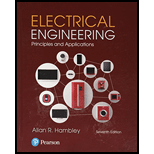
Broadly speaking, what are the two main objectives of electrical systems?
To discuss:
The two main objectives of electrical systems.
Explanation of Solution
The two main objectives of the electrical systems are
- The aim of an electrical system is to collect, save, alter, transfer and exhibit the information.
- Another aim of the electrical system is to generate, transmit, convert, distribute and store energy in various forms.
Energy is generated at the far stations because of several reasons like availability of the raw material, manpower, land and many more. It is generated at low voltage and then the voltage is raised as the losses are lesser in case of high voltages. To distribute it to the loads, the voltage is again stepped down as per the load requirement. This stepping up and stepping down of energy is done with the help of a device called transformer. Storing, processing and transfer of information is also a very essential part of an electrical system.
Want to see more full solutions like this?
Chapter 1 Solutions
Electrical Engineering: Principles & Applications (7th Edition)
Additional Engineering Textbook Solutions
Concepts Of Programming Languages
Java How to Program, Early Objects (11th Edition) (Deitel: How to Program)
Starting Out With Visual Basic (8th Edition)
Modern Database Management
Starting Out with C++ from Control Structures to Objects (9th Edition)
Java: An Introduction to Problem Solving and Programming (8th Edition)
- 3. Describe the function of the lowpass filter (LPF) used in CVSD system.arrow_forwardDon't use ai to answer I will report you answerarrow_forwardRL +Vcc a VCE 2. a) For the direct coupled class A amplifier shown, derive the expression for efficiency in terms of maximum and minimum values of currents and voltages. b) Determine the maximum efficiency of this circuit. c) Derive the expression for maximum power dissipation. www 9 www RB in VBEarrow_forward
- The joint probability density function of two discrete random variables X and Y is given by p(x, y)=c(2x+y), where x and y can assume all integers such that 0≤ x≤2, 0≤ y ≤ 3, and p (x, y)= 0 otherwise. a) Find the value of the constant c. (c) Find P(X≥1, Y≤2). (b) Find P(X=2, Y= 1).arrow_forwardA wattmeter is connected with the positive lead on phase "a" of a three-phase system. The negative lead is connected to phase "b". A separate wattmeter has the positive lead connected to phase "c". The negative lead of this wattmeter is connected also to phase "b". If the input voltage is 208 volts line-to- line, the phase sequence is "abc" and the load is 1200 ohm resistors connected in "Y", what is the expected reading of each of the wattmeters? (Hint: draw a phasor diagram)arrow_forward1- Write the mesh equation for the circuit below. Solve the equations using Crame method (matrix and determinant), and find the current of resistor 4 ohm. 6 A www 10 Ω w 6Ω www 12 V + 402 www 12 Ω 2- Write the nodal equations for the circuit below. You do not need to solve the equation just write the matrix equation. R3 ww 8Ω R₁ 201 5 A 12 3A R₂40arrow_forward
- Please solve these 3 questions in detailarrow_forward1. Please draw the root locus by hand for the following closed-loop system, where G(s) s+8 S-2 and H(s) = Find the range of K for stability Input R(s) Output C(s) KG(s) H(s) s+6 = S-2arrow_forwardThe state-space Jordan Canonical Form of the following system is: Y(s) 8-5 U(s) (+1)(+3) Select one: O a. -1 0 0 A = 0 -1 0 B: ... ... ... 0 0 C [4 1.5 1.5], D=0 b. -3 1 0 0 A = 0 -3 0 1 B ... 0 0 -1 C -4 -1.5 1.5], D=0 ○ C. -3 1 0 A = 0 -3 0 1 ,B= ... 0 0 ○ d. C [4 1.5 1.5], D=0 -3 1 0 0 A = 0 -3 0 1 , B: ... ... 0 0 -1 C [4 1.5 1.5], D=0 -4 1 If= x and (0): = then 2(t) is: -4 0 Select one: a. x2(t)=4te2t O b. x2(t) = e2t+2te2t Oc. 2(t)=-4te-21 Od. 2(t) e2-2te-2 =arrow_forward
 Introductory Circuit Analysis (13th Edition)Electrical EngineeringISBN:9780133923605Author:Robert L. BoylestadPublisher:PEARSON
Introductory Circuit Analysis (13th Edition)Electrical EngineeringISBN:9780133923605Author:Robert L. BoylestadPublisher:PEARSON Delmar's Standard Textbook Of ElectricityElectrical EngineeringISBN:9781337900348Author:Stephen L. HermanPublisher:Cengage Learning
Delmar's Standard Textbook Of ElectricityElectrical EngineeringISBN:9781337900348Author:Stephen L. HermanPublisher:Cengage Learning Programmable Logic ControllersElectrical EngineeringISBN:9780073373843Author:Frank D. PetruzellaPublisher:McGraw-Hill Education
Programmable Logic ControllersElectrical EngineeringISBN:9780073373843Author:Frank D. PetruzellaPublisher:McGraw-Hill Education Fundamentals of Electric CircuitsElectrical EngineeringISBN:9780078028229Author:Charles K Alexander, Matthew SadikuPublisher:McGraw-Hill Education
Fundamentals of Electric CircuitsElectrical EngineeringISBN:9780078028229Author:Charles K Alexander, Matthew SadikuPublisher:McGraw-Hill Education Electric Circuits. (11th Edition)Electrical EngineeringISBN:9780134746968Author:James W. Nilsson, Susan RiedelPublisher:PEARSON
Electric Circuits. (11th Edition)Electrical EngineeringISBN:9780134746968Author:James W. Nilsson, Susan RiedelPublisher:PEARSON Engineering ElectromagneticsElectrical EngineeringISBN:9780078028151Author:Hayt, William H. (william Hart), Jr, BUCK, John A.Publisher:Mcgraw-hill Education,
Engineering ElectromagneticsElectrical EngineeringISBN:9780078028151Author:Hayt, William H. (william Hart), Jr, BUCK, John A.Publisher:Mcgraw-hill Education,





